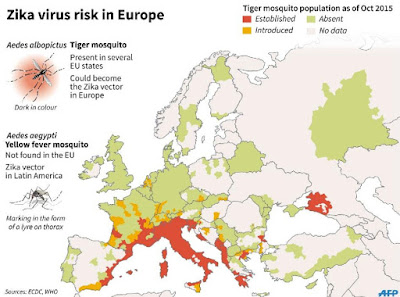Flaviviruses are as big as 40 – 50 nm and they have single stranded RNA. They are round with lipoprotein envelope and glikoproteins. These viruses are sensitive to organic solvents, UV light, 3% formaldehyde, 2% glutaraldehyde, γ rays; and they dissolve at 56°C/30 min. They can be contained at -60°C for a longer period of time.
The reproduction:
- Flavivirus enters the host cell with endocitosis after connecting the E-protein on cell receptors. The fusion of the virus envelope and membrane brings to the release of nucleocapsid in the cytoplasm of the host cell. That's where the translation of the RNA genome occures. The nucleus of the cell is not part of the virus replication process. All virus proteins are formed as long poliproteins (with more than 3000 aminoacids) which are then cut into smaller proteins with the help of viruses and cells protease. Flaviviruses develop by budding through the intercelular membrane into the cytoplasm vesicles, which merge to the celular membrane of the infected cell and the matured virus is released into the outer environment. [1]
Image: Zika virus risk in Europe by ECDC, WHO
The more recent outbrake of the Flavivirus is the ZIKA virus.
Zika virus was first introduced in 1947 when it was isolated from a rhesus monkey in Uganda who developed a fewer after being put in a cage in the Zika forrest for monitoring the sylvatic yellow fewer. First isolation of this virus found in humans was in 1952. In 2007 there were about 100 cases of zika virus known outside of Africa and Asia with no hospitalization or deaths. In 2013 – 2015 there's been new outbrake of the zika virus that continues to the 2016. The outbrake started in Brazil and is transmitted by Aedes aegypti mosquitos (they also transmit dengue, chikungunya and yellow fever).[2]
The most common symptomes are fever, rash, joint pain, or conjunctivitis (red eyes). Other common symptoms include muscle pain and headache. Very similar to the dengue. The incubation period (time from exposure to symptomes) is not known but is likely to be few days. Some people never develop any symptomes. However there are doubts if it is connected to the birth defects such as microcephaly in recently born children. Since the outbrake in Brazil there have been few reports on the Guillain-Barré syndrome (disorder in which the body's immune system attacks part of the peripheral nervous system). The hospitalization is uncommon and deaths are rare. [3]
Diagnosis of zika is done through PCR (polymerase chain reaction) and the virus infected blood samples. However it's rather difficult to detect and name the virus since it can cross-react with other flaviviruses such as dengue, West Nile and yellow fever.[4]
WHO advises the infected countries to start the extermination of the mosquitos. Until then it's important to protect yourself from mosquito bites by: wearing clothes that hide as much of the body as it's possible, sleeping under mosquito nets, using anti-insect creames, closing the windows and doors.
Zika virus disease is usually relatively mild and requires no specific treatment. However there's no vaccine available yet.
Ines Poljak
student of Medical Laboratory Diagnostics, ZVU, Croatia
References:
[1] G. Mlinarić Galinović, M. Ramljak Šešo; Special medical microbiology and parasitology; ZVU, Zagreb 2013.
[2] paho.org
[3] cdc.gov
[4] who.int








2 comments:
Is known how long the virus stays in the body of the guest (i mean if it's like herpes virus).
Then, if the science links this virus with microcephaly, does the infection will be a risk only during pregnancy or once infected the risk remains lifelong?
Thanks
Post a Comment